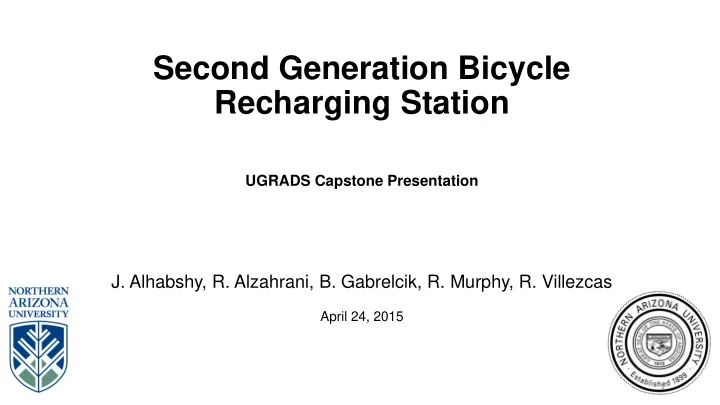

Second Generation Bicycle Recharging Station UGRADS Capstone Presentation J. Alhabshy, R. Alzahrani, B. Gabrelcik, R. Murphy, R. Villezcas April 24, 2015 1
Overview Project Definition Final Design Alternator and Mounting System Electrical System (Capacitor and Inverter) Display System (Outlets and Meters) Testing Results Speed Requirements Phone Battery Charge Rates AC Inverter Efficiency Video Preview Project Conclusion Real Life Application Alhabshy 2
First Generation Used Lead-Acid batteries to store excess energy and stabilize current coming from the DC motor. Only provided DC power to specifically built in phone chargers. Possessed no gears to change the required riding speeds Was not designed with mobility in mind Alhabshy 3
Project Goal Goal: Design and improve a version of the first generation bicycle recharging station Alhabshy 4
Project Objectives Objective Measurement Units Powers Small Electronics Test with a Load Bank Watts Durable Display Surface Roughness/Scratches Number of Scratches Reliable Design Maintenance Costs Dollars Efficient Storage System Test System Load Capacity Watts Inexpensive Cost of Additional Components Dollars Aesthetically Pleasing Compare Survey Results Survey Alhabshy 5
Constraints Capable of charging common electronic devices in only a few hours Charging station must be capable of being converted from stationary to mobile in only a few minutes Alhabshy 6
Final Design Alternator Mounting System Alternator Mounting System Mobility Feature Electrical System Capacitor Inverter DC Converter Display System AC and DC Outlets Voltage and Current Displays Alhabshy 7
Design Summary - Alternator A single-wire, self-exciting alternator was used No initial charge required to start up Contains an internal voltage regulator Capable of producing large amounts of power Villezcas 8
Design Summary - Mounting System Built from a stationary bike stand Allows the alternator to be easily disengaged Can attach to bike above the rear tire to allow mobility Villezcas 9
Design Summary – Electrical System Converts alternator power to usable DC and AC current Designed to handle up to 300 Watts Open terminals to allow external loads to be added if desired Villezcas 10
Design Summary - Capacitor Purpose is to stabilize the fluctuating current coming from the alternator Designed to be used in automotive stereo systems Can handle up to 1000 Watts of power (more than three times our maximum output) Villezcas 11
Design Summary - Inverter Purpose is to convert DC voltage into usable AC power supply Capable of supplying up to 300 watts of power Built in DC/DC converter that provides power universal USB plugs Villezcas 12
Design Summary – Display System Houses commonly used outlets to easily provide AC and DC power for the rider Measures and displays the voltage and current for both the DC and AC power supply Villezcas 13
Design Summary – Display Meters DC display uses a shunt device to measure the amps going to the DC output Both meters display real time measurements to help the rider understand the power they’re producing Villezcas 14
Testing Results Speed Requirements Speed required at various power outputs Battery Charge Rates Amount of battery charged in a single hour AC Inverter Efficiency Overall efficiency as power output is increased Murphy 15
Testing Results – Speed Requirements Increase in required speed is relatively low as power output increases Speeds were not too high for normal operations Gears can be changed to allow easier use of the station Murphy 16
Testing Results – Battery Charge Rate Increase in Battery Charge consistent for both the bike and an average wall outlet Increase of 46% after one hour of charging on the station Estimated time to charge a phone was around 125 minutes Murphy 17
Testing Results – AC Inverter Efficiency Efficiency approximately 80% when the power output is greater than 90 watts Inefficient when the load is lower than 90 watts Murphy 18
Video of Project in Action https://www.youtube.com/watch?v=SC1QdhcDu6Y (for online viewers) Murphy 19
Project Conclusion The charging station is capable of powering multiple electronic devices at once The station can provide up to 300 watts of AC power to the rider The design can be mobile by simply detaching the alternator and rotating the mounting system The entire system increases efficiency from the previous design by utilizing a large capacitor instead of lead-acid batteries Murphy 20
Applied in Real Life Can be used in third world countries to provide clean renewable energy Promotes a healthy lifestyle while teaching about the benefits of renewable energy Is a relatively simple design that can be replicated with ease Murphy 21
References [1] Bird, John (2010). Electrical and Electronic Principles and Technology. Routledge. Pp. 63-76 ISBN 9780080890562. Retrieved 2014-10-17. [2] “440 Watt Regulated Pedal Power Bicycle Generator” bdwhaley. Available: http://www.instructables.com/id/Bicyle-Power-for-Your-Television,-Laptop,-or-Cell-/ [3] "Generators". IEEE Global History Network. Retrieved 22 September 2014. Murphy 22
Questions Murphy 23
Recommend
More recommend